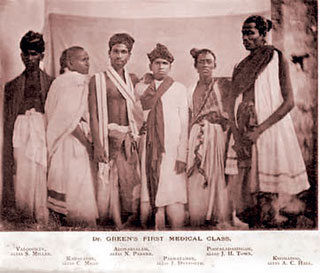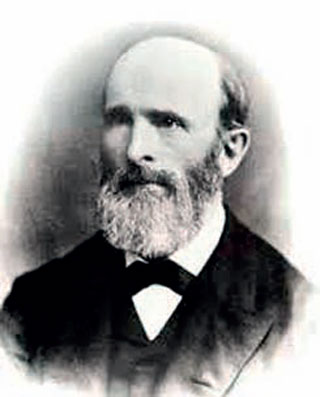Thursday Dec 11, 2025
Thursday Dec 11, 2025
Monday, 10 October 2022 00:00 - - {{hitsCtrl.values.hits}}
By Dr. Thayalan Ambalavanar
 |
| Dr. Green's first medical class - Circa 1848 |
 |
| Dr. Samuel Fisk Green |
The lives of great men and women leave indelible marks on the pages of history. They serve to act as role models and to inspire us as we strive to make our world a better place. Dr. Samuel Fisk Green was an inspiring figure whose vision and legacy altered the medical landscape of the island of Ceylon in ways that he may not have fully comprehended at the time. On his 200th birth anniversary on 10 October it is only fitting that his legacy is recalled.
While a young medical student I had become very much aware of the significant contributions made by generations of American missionaries who had served in Jaffna and helped transform the social, cultural, educational and medical landscape of the peninsula in ways that are still evident. As a young doctor I had the great privilege of working in the hospital that Samuel Green founded and understanding even more the greatness of this man. He has long been an inspiration and a hero to me.
Today in the 21st century, international travel is not something most people think twice about. This was certainly not the case when the American missionaries first set out to travel to distant lands. These missionaries did so out of a deep commitment and worked for the holistic transformation of society by sharing the very best of the educational and scientific knowledge available to them. They also sought to address human suffering. They themselves were exposed to the burdens of ill health and bore great personal losses in their journey to Ceylon and during their life here.
Samuel Green set out for Jaffna in 1847. The journey took him four and a half months by ship but he used that time wisely by learning Tamil during the voyage.
Green the physician
Following his arrival in 1847, his acceptance and fame as a doctor followed his successful treatment of a well-known Tamil and Sanskrit pundit, Mutathamby, for a large abdominal abscess that had not responded to the ministrations of the traditional practitioners. He was an extremely successful doctor who served and saved thousands of patients at Manipay and Jaffna. To contemplate the hundreds of varied operations that he carried out with very basic or no anaesthesia is a cause for amazement. The operations varied from cataracts to removal of tumours, some of which were complex even by today’s standards including of the oral cavity, fixing of fractures, treating surgical infections and so on.
He quickly observed and understood the main medical problems of his time. He observed that oral cancer was common and that it was caused by the use of slaked lime on the betel leaves that were commonly chewed and that diabetes and obesity were a common problem. Infections such as cholera, smallpox, malaria and pneumonia were also diseases that he had to deal with.
Green and medical education
Green understood that the needs for healthcare in the peninsula were far too much for him to provide on his own so he set about to solve that problem. He did so by training young local men as doctors! He selected students who had studied in English and graduated from the Batticotta seminary (now Jaffna College) as his first students. In doing so in 1848 he established the first medical school in the island of Ceylon at Manipay and thus also made his American Mission Dispensary the first teaching hospital in the island! These are the traits of great leaders and visionaries.
As the training took place and he produced batches of students he was faced with new challenges. He was so successful in his efforts at producing locally trained doctors that the British colonial government promptly gave them jobs not just in Jaffna but outside as well. The quality of training resulted in producing doctors of excellent standard. This was vouchsafed for by Rev. B. Bailey, the chaplain to the Bishop of Colombo, who during a visit to Jaffna saw one of Green’s students working at the government hospital and stated that he possessed ‘acquirements equal to the majority of the young men who enter the medical profession in England’! This resulted in many of Green’s graduates being posted outside Jaffna and made Green wonder how he could reduce this problem. His solution was to teach medicine in Tamil so that the doctors trained would be better able to serve the local community and, hopefully, also remain in the area!
For anybody in those days to undertake such a herculean task was challenging enough let alone an American. However, Green was not in the least daunted and with the help of his Tamil students proceeded to translate many of the medical books of his time into Tamil. These books included Cutter’s Anatomy, Physiology and Hygiene, Gray’s Anatomy, Maunsell’s Obstetrics, Druitt’s Surgery, Dalton’s Physiology and many more. His task was made easier by the fact that the American Mission had already established the first printing press in the north which was also producing the second oldest newspaper in Ceylon, The Morning Star.
All in all he trained 62 students of whom 33 were taught in Tamil. Besides them he had started another 20 well into their training before he finally left in 1873.
Green and Jaffna Hospital
Such was Green’s reputation as a doctor that in addition to his work at the hospital in Manipay, he was requested by the British Government Agent of Jaffna, Percival Dyke, to help support a hospital in Jaffna town. Thus did the Friends in Need Society Hospital in Jaffna get Green’s help in becoming a well-established hospital in 1850. This was to be the forerunner to today’s Teaching Hospital in Jaffna. Green served as a visiting surgeon and Superintendent for many years at the FINS hospital. It was his students who served that hospital as doctors till as late as 1907.
Ten years after arriving in Jaffna, Green returned to the US in 1857. This was mainly due to his poor health after suffering from cholera. During the five years he was there he married Margaret. Green returned to Jaffna in 1862 accompanied by his wife. He was to have four children (three daughters and a son) during this stay in Jaffna. He continued his immense work of service and training during the next 10 years he was to be there.
A man ahead of his time
During the days of the current COVID pandemic, hand washing and hygiene again came to the fore as one of the important measures to reduce the transmission of disease. Green was carrying this out way back in 1850 as borne out by this quote from a letter he wrote. “A Brahmin wished me to examine his wife’s case when there was no crowd present, and to avoid putting my fingers in her mouth. I told him that I should touch her no more than was requisite and he need not fear pollution, for I should wash my hands immediately before; and she would not pollute me, as I should wash them just afterwards”. That is a quotation that every practicing and aspiring medic should be made to read!
The last farewell
Green departed the shores of Jaffna for the last time in 1873 though with the hope that he would return to continue his work. The American mission decided not to send him as they felt that his health was not good and because he had a young family. The mission also decided to stop funding the medical school. This was due to the fact that the British had started a medical school in Colombo in 1870. Jaffna had to wait another hundred years for the establishment of a medical school, the Faculty of Medicine, in 1978!
Till his dying days Green’s thoughts were very much about Jaffna and its people. In his will he had stated that ‘should I ever have a gravestone, let it be plain and simple, and bear the following inscription:
Samuel Fisk Green,
Medical Evangelist to the Tamils.
Jesus my all’
He died on 28 May 1884.
(Reference: Life and Letters of Samuel Fisk Green, M.D. of Green Hill compiled by Ebenezer Cutler.)(The writer is a Visiting Lecturer in Surgery, Faculty of Medicine, Jaffna.)